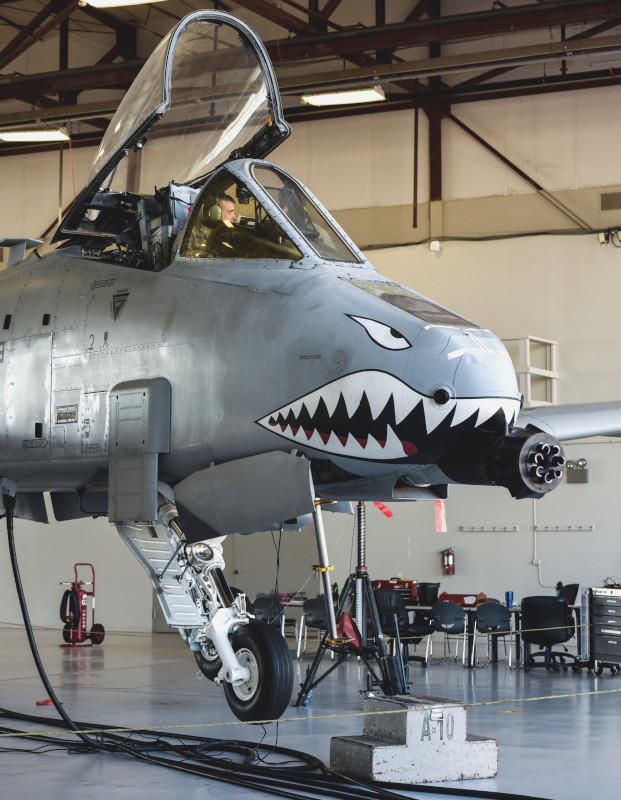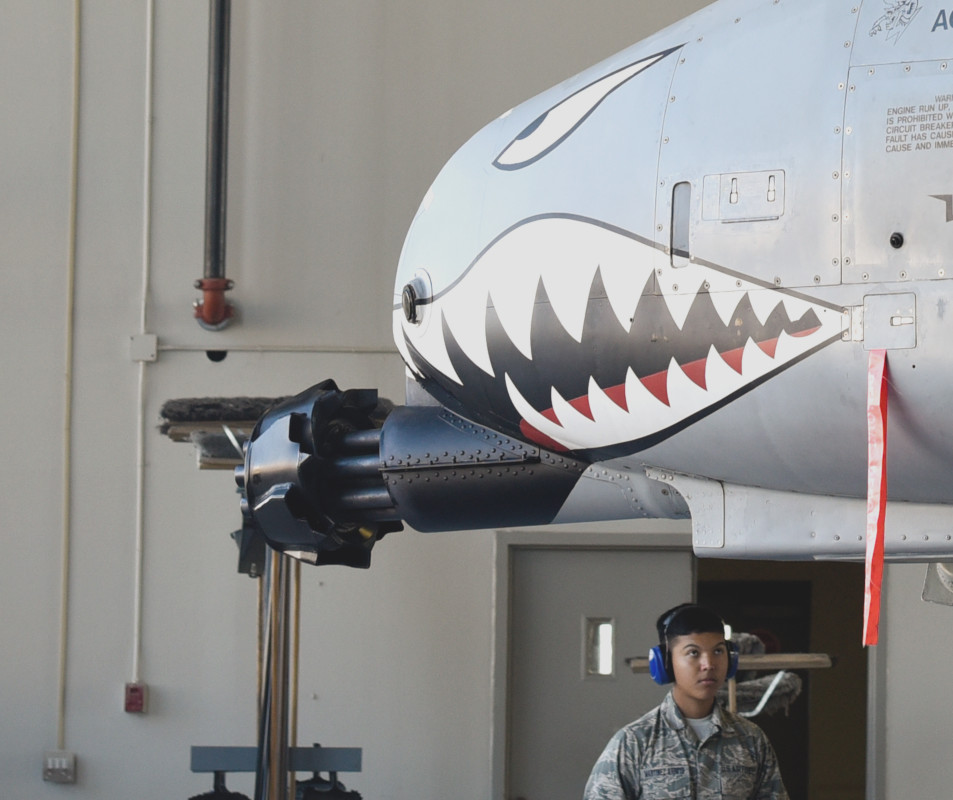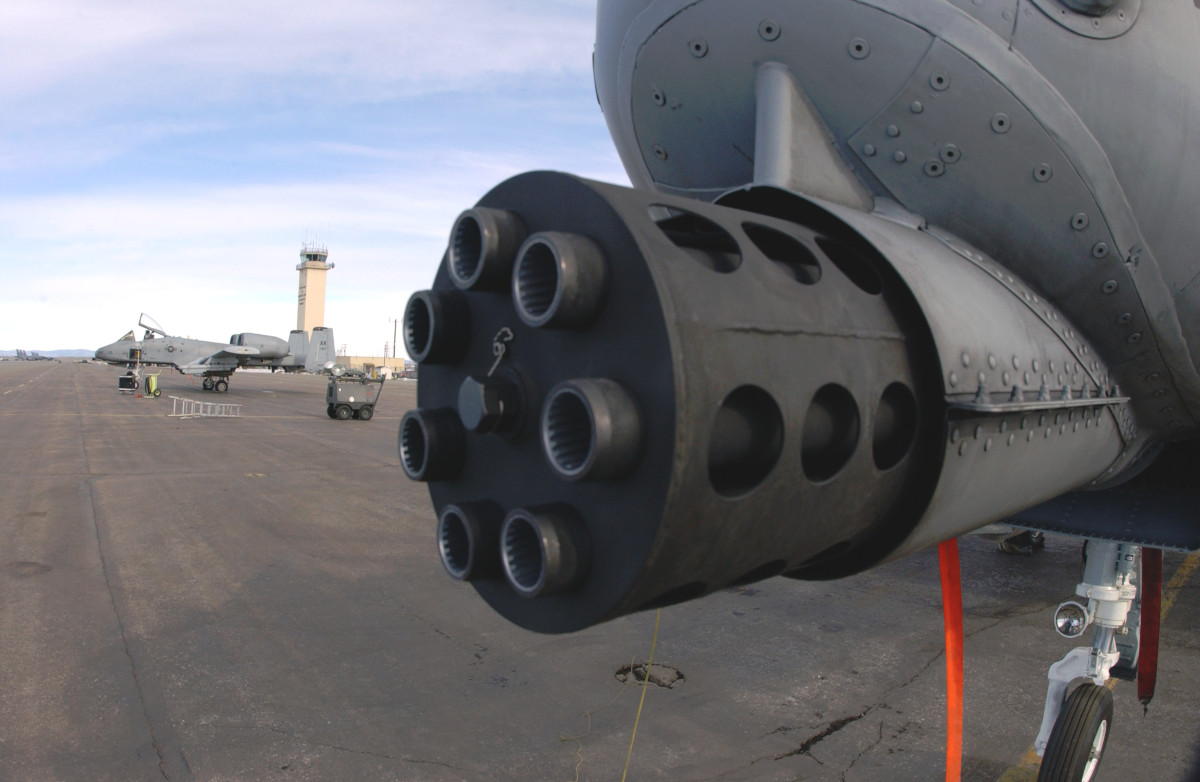Every year, the U.S. Air Force’s 82nd Training Wing at Sheppard Air Force Base in Texas prepares thousands of airmen to become maintainers and munitions specialists, or to improve their skills, and it uses a number of non-flyable aircraft to help with those training courses. But one of its permanently grounded GA-10A Warthogs is also something of a unique historical article with a rarely seen muzzle device, nicknamed “the Tickler,” on its 30mm GAU-8/A Avenger cannon, which operational units only ever used briefly decades ago.
On Oct. 10, 2018, the 82nd’s public affairs office posted otherwise unassuming pictures online of trainees from the 362nd Training Squadron using the GA-10 to practice conducting a landing gear function check. The add-on muzzle device it has was originally supposed to help mitigate the shock and blast of firing the massive gun and help deflect and disperse fumes that could choke out the aircraft’s engines, but proved to be problematic in its own right.
We reached out to the Wing for more information about this particular Warthog and they confirmed that it is an instructional trainer airframe. At the time of writing, they had not yet been able to provide the plane’s specific serial number or explain why it still has the muzzle device installed. The unit has received a number of grounded Warthogs over the years, including some of the earliest developmental examples.
“The A-10 is one of the hardest planes to take down [for maintenance],” one of the 362nd’s instructors said, according to a caption for one of the pictures. This is “because of all the back-up/emergency systems it has that the pilot can fall back on when worse comes to worst.”

Defense contractor Battelle developed the Tickler, also known more formally as the Gun Gas Diverter or the GFU-16/A, as another safety measure. During development of the Avenger cannon, which occurred in parallel with that of the A-10 itself, it quickly became apparent that without any sort of flash hider or muzzle brake on the end, the gun would blind the pilot during firing. Soot would also build up on the windshield, eventually blocking the pilot’s view in general.
On top of that, the gasses the weapon produced as a by-product of firing could end up getting sucked into either of the Warthog’s two engines. These fumes contained no oxygen, which could starve the jets of air and cause them to stall, and might have unburnt gunpowder in them, which could cause even more serious problems.
The A-10’s manufacturer, Republic, and the Air Force spent considerable effort during the plane’s developmental period and early service life searching for ways to solve these issues, which we at The War Zone
have explored in detail in the past. Battelle’s GFU-16/A was the last of these projects, with work related to the device continuing into the late 1980s.
The muzzle brake has two sets of baffles inside intended to eliminate the flash from firing and help disperse the gun gasses before they exit the device. By all accounts, it was quite successful in performing both of these functions. The Air Force sent the GFU-16/As out to various A-10 units, which dutifully installed them on their aircraft.

Unfortunately, the devices also created new and problematic turbulence at the muzzle and magnified the gun’s already severe vibration. This, in turn, led to severe cracking in portions of the forward fuselage, especially inside the gun bay, which became more apparent as time went on.
“Although at this time this cracking is not believed to be a flight safety problem, it is a maintenance burden and could have an impact on the operational readiness of the A-10 force,” one 1986 report explained. At that time, the Air Force had initiated a program to “find a solution to the A-10A gun bay fatigue problem by determining the source of the structural fatigue and applying and verifying airframe modifications to achieve the desired structural design life.”

The source, of course, was the muzzle device. We don’t know the exact results of the flight test program, but what is clear is that the Air Force concluded there was no cost-effective way to fix the problem and quickly ordered units to remove the GFU-16/As permanently.
Today, A-10s feature a more traditional-looking muzzle device. The Air Force largely gave up on trying to fight the adverse effects of firing the gun, as well. Warthog pilots can use a special windshield wiping system to clean off the windscreen and pulling the trigger also constantly trips the engine ignition system. So, even if the gasses do cause the engines to fail, they immediately restart. A change in the gunpowder inside the 30mm ammunition also helped mitigate the problem.
Watch what happens to the bubble compass to the right of the pilot’s heads-up display in the video below to get a sense of just how much force the GAU-8/A exerts on an A-10 during firing.

Still, there are anecdotal reports from as recently as 2007 that some units still had the gun gas diverters sitting around in their parts lockers and, obviously, at least one GA-10A at Sheppard still has its GFU-16/A fitted. Since it is no longer in service, it would serve no training purpose. It doesn’t appear to have any impact on the kind of training that the 362nd uses that airframe for, either, suggesting it was just easier to leave it on.
Regardless, it’s still a cool piece of A-10 history, albeit one that might be better served preserved in a museum at this point.

Update: 11/28/2018—
We have received some additional information from Sheppard Air Force Base regarding this aircraft, which is actually a GA-10C and has the serial number 80-0228. The 82nd Training Wing received its first C model instructional aircraft in 2015.
When 80-228 arrived, crews removed the Gun Gas Diverter from a GA-10A that was heading to the Bone Yard at Davis-Monthan Air Force Base and installed it on the newer aircraft. The 82nd specifically did this in order to ensure the preservation of this piece of history and students working on the aircraft get a brief description of its origins and purpose during training courses.
Contact the author: jtrevithickpr@gmail.com
